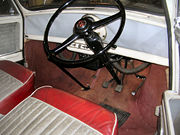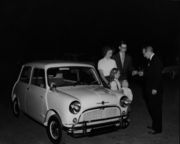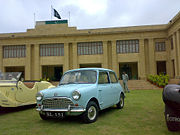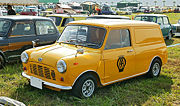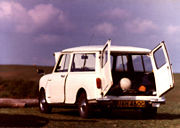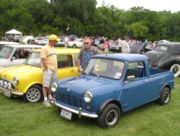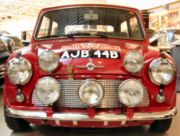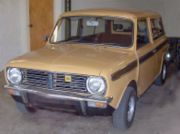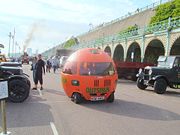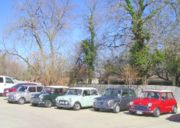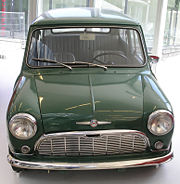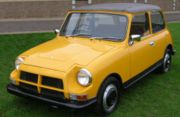Mini
2008/9 Schools Wikipedia Selection. Related subjects: Road transport
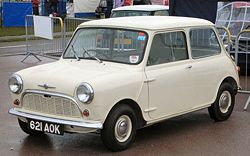 |
|
| Manufacturer | BMC to MG Rover, and Innocenti, Authi |
|---|---|
| Production | 1959–2000 |
| Assembly | Longbridge, Birmingham, West Midlands, England, Cowley, Oxfordshire, England |
| Successor | BMW MINI |
| Class | Supermini |
| Body style(s) | 2-door saloon 2-door estate 2-door van 2-door truck |
| Layout | FF layout |
| Engine(s) | A-series, 850–1275 cc |
| Transmission(s) | 4-speed manual 4-speed automatic/ 5 speed manual (some models only) |
| Wheelbase | 2.04 m (80.3 in) (saloon) 2.14 m (84.3 in) (estate and commercials) |
| Length | 3.05 m (120.1 in) (saloon) 3.40 m (133.9 in) (estate and commercials) |
| Width | 1.40 m (55.1 in) |
| Height | 1.35 m (53.1 in) |
| Kerb weight | 617 kg (1,360 lb) to 686 kg (1,512 lb) |
| Designer | Sir Alec Issigonis |
The Mini is a small car that was produced by the British Motor Corporation (BMC) and its successors from 1959 until 2000. The most popular British-made car ever, it was superseded by the New MINI, which was launched in April 2001. The original is considered an icon of the 1960s, and its space-saving front-wheel-drive layout (that allowed 80% of the area of the car's floorpan to be used for passengers and luggage) influenced a generation of car-makers. The vehicle is in some ways considered the British equivalent to its German contemporary, the Volkswagen Beetle, which enjoyed similar popularity in North America.
This distinctive two-door car was designed for BMC by Sir Alec Issigonis. It was manufactured at the Longbridge and Cowley plants in the United Kingdom, the Victoria Park / Zetland British Motor Corporation (Australia) factory in Sydney Australia, and later also in Spain ( Authi), Belgium, Chile, Italy, Portugal, South Africa, Uruguay, Venezuela and Yugoslavia. The Mini Mark I had three major UK updates: the Mark II, the Clubman and the Mark III. Within these was a series of variations including an estate car, a pickup truck, a van and the Mini Moke — a jeep-like buggy. The Mini Cooper and Cooper "S" were sportier versions that were successful as rally cars, winning the Monte Carlo Rally three times.
Minis were marketed under the Austin and Morris names until Mini became a marque in its own right in 1969.
Design and development
Designed as project ADO15 ( Austin Drawing Office project number 15), the Mini came about because of a fuel shortage. In 1956, as a result of the Suez Crisis which reduced oil supplies, the United Kingdom saw the re-introduction of petrol rationing. Sales of large cars slumped, and there was a boom in the market for so called Bubble cars, which were mainly German in origin. Leonard Lord, the somewhat autocratic head of BMC, decreed that something had to be done quickly. He laid down some basic design requirements: the car should be contained within a box that measured 10 × 4 × 4 feet (3 × 1.2 × 1.2 m); and the passenger accommodation should occupy six feet (1.8 m) of the 10 foot (3 m) length; and the engine, for reasons of cost, should be an existing unit. Issigonis, who had been working for Alvis, had been recruited back to BMC in 1955 and, with his skills in designing small cars, was a natural for the task. The team that designed the Mini was remarkably small: as well as Issigonis, there was Jack Daniels (who had worked with him on the Morris Minor), Chris Kingham (who had been with him at Alvis), two engineering students and four draughtsmen. Together, by October 1957, they had designed and built the original prototype, which was affectionately named 'The Orange Box' because of its colour.
The ADO15 used a conventional BMC A-Series four-cylinder water-cooled engine, but departed from tradition by having it mounted transversely, with the engine-oil-lubricated, four-speed transmission in the sump, and by employing front-wheel drive. Almost all small front-wheel-drive cars developed since have used a similar configuration. The radiator was mounted at the left side of the car so that the engine-mounted fan could be retained, but with reversed pitch so that it blew air into the natural low pressure area under the front wing. This location saved precious vehicle length, but had the disadvantage of feeding the radiator with air that had been heated by passing over the engine.
The suspension system, designed by Issigonis' friend Dr. Alex Moulton at Moulton Developments Limited, used compact rubber cones instead of conventional springs. This ingenious design shrank the overall size of the suspension, meaning that it could take up less space. It was built into the subframes. The use of the rubber cones led to a rather raw and bumpy ride, but this rigidity, together with the wheels being pushed out to the corners of the car, gave the Mini its famous go kart-like handling. It was initially planned to use an interconnected fluid system — similar to the one which Issigonis and Moulton were working on in the mid-1950s at Alvis — but the short development time of the car meant this was not ready in time for the Mini's launch. The system intended for the Mini was further developed to become the hydrolastic system and was first used on the Austin 1100, launched in 1962. Ten-inch (254 mm) wheels were specified, so new tyres needed to be developed, the initial contract going to Dunlop.
The Mini was designed with sliding windows in the doors, thus allowing for storage pockets to be fitted in the space where a winding window mechanism would have been. Issigonis is said to have sized the resulting storage bins to take a bottle of his favourite Gordon's Gin. The boot lid was designed with the hinges at the bottom so that the car could be driven with it open to increase luggage space. On early cars the number plate was hinged so it swung down to remain visible when the boot lid was open. Although it has to be mentioned that this design was later discontinued as it was discovered that exhaust gasses could leak into the cockpit while the boot was open.
The Mini was designed as a monocoque shell with welded seams that are visible on the outside of the car running down the A and C pillars, and between the body and the floor pan showing where the joins are. To further simplify construction, the car had external door and boot hinges.
All of these novel and elegant technical innovations resulted in a car with minimum overall dimensions yet maximised space for both passengers and luggage.
Production models differed from the prototype by the addition of front and rear subframes to the unibody to take the suspension loads, and by turning the engine around with the carburettor at the back rather than at the front. This required an extra gear to be placed between engine and transmission to reverse the engine direction. Making this a reduction gear had the beneficial effect of reducing loads on the gearbox and preventing the rapid wear on the synchromesh which had been a problem on early prototypes. Having the carburettor at the rear helped to reduce carburettor icing, but did expose the distributor to water coming in through the grille. The engine size was reduced from 948 to 848 cc, which reduced the top speed from an unprecedented 90 mph (145 km/h) to a more manageable (for the time) 72 mph (116 km/h) — a decision that was reversed in 1967.
Despite its utilitarian origins, the classic Mini shape had become so iconic that by the 1990s, Rover Group — the heirs to BMC — were able to register its design as a trade mark in its own right.
The Mark I Mini: 1959-67
The production version of the Mini was demonstrated to the press in April 1959, and by August several thousand cars had been produced ready for the first sales.
The name Mini did not appear by itself immediately — the first models being marketed under two of BMC's brand names, Austin and Morris. The name Austin Seven (sometimes written as SE7EN in early publicity material) recalled the popular small Austin 7 of the 1920s and 1930s. The other name used till 1967 in the United Kingdom (and in Commonwealth countries such as Australia), Morris Mini-Minor, seems to have been a play on words. The Morris Minor was a well known and successful car, with the word minor being Latin for "smaller"; so an abbreviation of the Latin word for "smallest" — minimus — was used for the new even smaller car. It was originally going to be called the Austin Newmarket.
Until 1962, the cars appeared as the Austin 850 and Morris 850 in North America and France, and in Denmark as the Austin Partner (until 1964) and Morris Mascot (until 1981). The name Mini was first used domestically by BMC for Austin's version in 1961, when the Austin Seven was rebranded as the Austin Mini, somewhat to the surprise of the Sharps Commercials car company (later known as Bond Cars Ltd) who had been using the name
Minicar for their three-wheeled vehicles since 1949. However, legal action was somehow averted, and BMC used the name Mini for the remainder of the car's life.
In 1964, the suspension of the cars was replaced by another Moulton design, the hydrolastic system. The new suspension gave a softer ride but it also increased weight and production cost and, in the minds of many enthusiasts, spoiled the handling characteristics, for which the Mini was so famous. In 1971, the original rubber suspension reappeared and was retained for the remaining life of the Mini.
From October 1965 the option of an Automotive Products (AP) designed four-speed automatic transmission became available.
Slow at the outset, Mark I sales strengthened across most of the model lines in the 1960s, and production totalled 1,190,000. Sold at below cost, the basic Mini never made money for its makers. This may have been necessary in order to compete with its rivals, but it is rumoured that it was due to an accounting error. Some profits came from the popular deluxe models and from optional accessories, such as seat belts, door mirrors and a radio, which would be considered necessities on modern cars.
The Mini etched its place into popular culture in the 1960s with well-publicised purchases by film and music stars.
The Mark II Mini: 1967-70
From 1967 to 1970, Issigonis had been designing a replacement for the Mini in the form of an experimental model called the 9X. It was shorter and more powerful than the Mini, but due to politicking inside British Leyland (which had now been formed by the merger of BMC's parent company British Motor Holdings and the Leyland Motor Corporation), the car did not reach production.
It was an intriguing "might-have-been"; the car was technologically advanced, and many believe it would have been competitive up until the 1980s.
The Mark II Mini featured a redesigned front grille which remained with the car from that point on. Also, a larger rear window and numerous cosmetic changes were introduced. 429,000 Mark II Minis were made.
A bewildering variety of Mini types were made in Pamplona, Spain, by the Authi company from 1968 onwards, mostly under the Morris name.
The Mini was arguably the star of the 1969 film The Italian Job, which features a car chase in which a gang of thieves drive three Minis down staircases, through storm drains, over buildings and finally into the back of a moving bus. This film was remade in 2003 using the new MINI.
Variants
The popularity of the original Mini spawned many models that targeted different markets:
Wolseley Hornet and Riley Elf (1961–69): built as more luxurious versions of the Mini, both the Wolseley Hornet and the Riley elf had longer, slightly finned rear wings and larger boots that gave the cars a more traditional “ notchback” look. Front-end treatment, which incorporated each marque’s traditional upright grille design, also contributed to a less utilitarian appearance. The cars had larger-diameter chrome hubcaps than the Austin and Morris Minis, also additional chrome accents, bumper overriders and wood-veneer dashboards. The Riley was the more expensive version of the two cars. The name "Wolseley Hornet" was first used on a 1930s sports car, while the name "Elf" recalled the Riley Sprite and Imp sports cars, also of the 1930s.
Both cars went through three versions. Initially, they used the 848 cc engine, changing to a single carburettor version of the Cooper's 998 cc power unit in the Mark II in 1963. The MKIII facelift of 1966 brought wind-up windows and fresh-air fascia vents; also concealed door hinges two years before these were seen on the mainstream Mini. 30,912 Riley Elfs and 28,455 Wolseley Hornets were built.
Morris Mini Traveller and Austin Mini Countryman (1961–69, UK only): Two-door estate cars with double "barn"-style rear doors. Both were built on a slightly longer chassis of 84 inches (2.14 m) compared to 80.25 inches (2.04 m) for the saloon.
The luxury models had decorative, non-structural wood inserts in the rear body which gave the car a similar appearance to the larger Morris Minor estate which had some of the look of an American-style 1950s Woodie. Approximately 108,000 Austin Mini Countrymen and 99,000 Morris Mini Travellers were built.
Mini Van (1960-82): A commercial panel van rated at ¼-ton load capacity. Built on the longer Traveller chassis but without side windows, it proved popular in 1960s Britain as a cheaper alternative to the car as it was classed as a commercial vehicle and carried no sales tax. A set of simple stamped steel slots served in place of a more costly chrome grille. The Mini Van was renamed as the Mini 95 in 1978, the number representing the gross vehicle weight of 0.95 tons. 521,494 were built.
Mini Moke (1964 and 1968 in the UK, 1966-82 in Australia and 1983-89 in Portugal): A utility vehicle designed for the British Army, for whom 600 twin-engined 4-wheel-drive versions were purpose-built. Although the 4WD Moke could climb a 2-in-1 gradient, it proved to have insufficient ground clearance for military use. The single-engined front-wheel-drive Moke enjoyed some popularity in civilian production. About 50,000 were made. The car featured in the cult 1967 TV series The Prisoner, and is popular in holiday locations such as Barbados and Macau, where Mokes were used as police cars. Mokes were also available to rent there as recently as March 2006. "Moke" is archaic British slang for a donkey.
Mini Pick-up (1961-82): A pick-up truck, 11 feet from nose to tail, built on the longer Mini Van platform, with an open-top rear cargo area and a tailgate. The factory specified the weight of the Pickup as less than 1500 lbs with a full six gallons of fuel.
As with the Van, the pickup did not have a costly chrome grille. Instead, a simple set of stamped metal slots allowed airflow into the engine compartment. The Pickup was spartan in basic form, although the factory brochure informed prospective buyers that “[a] fully equipped Mini Pick-up is also available which includes a recirculatory heater.” Passenger-side sun visor, seat belts, laminated windscreen, tilt tubes and cover were available at extra cost. Like the van, the Pickup was renamed as the Mini 95 in 1978.
A total of 58,179 Mini Pickups were built.
The Mini Cooper and Cooper S: 1961-2000
Issigonis' friend John Cooper, owner of the Cooper Car Company and designer and builder of Formula 1 and rally cars, saw the potential of the Mini for competition. Issigonis was initially reluctant to see the Mini in the role of a performance car, but after John Cooper appealed to BMC management, the two men collaborated to create the Mini Cooper, a nimble, economical and inexpensive car. The Austin Mini Cooper and Morris Mini Cooper debuted in 1961.
The original 848 cc engine from the Morris Mini-Minor was increased to 997 cc, boosting power from 34 bhp to 55 bhp (25 to 41 kW). The car featured a racing-tuned engine, twin SU carburettors, a closer-ratio gearbox and front disc brakes, uncommon at the time in a small car. One thousand units of this version were commissioned by management, intended for and designed to meet the homologation rules of Group 2 rally racing. The 997 cc engine was replaced by a shorter stroke 998 cc unit in 1964.
A more powerful Mini Cooper, dubbed the "S", was developed in tandem and released in 1963. Featuring a 1071 cc engine and larger servo-assisted disc brakes, 4,030 Cooper S cars were produced and sold until the model was updated in August 1964. Cooper also produced two models specifically for circuit racing, rated at 970 cc and a 1275 cc, both of which were also offered to the public. The smaller-engine model was not well received, and only 963 had been built when the model was discontinued in 1965. The 1275 cc Cooper S models continued in production until 1971.
Sales of the Mini Cooper were as follows: 64,000 Mark I Coopers with 997 or 998 cc engines; 19,000 Mark I Cooper S with 970, 1071 or 1275 cc engines; 16,000 Mark II Coopers with 998 cc engines; 6,300 Mark II Cooper S with 1275 cc engines. There were no Mark III Coopers and just 1,570 Mark III Cooper S's.
The Mini Cooper S earned acclaim with Monte Carlo Rally victories in 1964, 1965 and 1967. Minis were initially placed first, second and third in the 1966 rally as well, but were disqualified after a controversial decision by the French judges. The disqualification related to the use of a variable resistance headlamp dimming circuit in place of a dual-filament lamp. It should be noted that the Citroën DS that was eventually awarded first place had illegal white headlamps but escaped disqualification. The driver of the Citroën, Pauli Toivonen, was reluctant to accept the trophy and vowed that he would never race for Citroën again. BMC probably received more publicity from the disqualification than they would have gained from a victory - but had the Mini not been disqualified, it would have been the only car in history to be placed in the top three on the Monte Carlo for six consecutive years.
| Year | Driver | Co-Driver | Result |
|---|---|---|---|
| 1962 | Pat Moss | Ann Wisdom | Ladies' Award |
| 1963 | Rauno Aaltonen | Tony Ambrose | 3rd Place |
| 1964 | Paddy Hopkirk | Henry Liddon | Winner |
| Timo Mäkinen | Patrick Vanson | 4th Place | |
| 1965 | Timo Mäkinen | Paul Easter | Winner |
| 1966 | Timo Mäkinen | Paul Easter | (disqualified) |
| Rauno Aaltonen | Tony Ambrose | (disqualified) | |
| Paddy Hopkirk | Henry Liddon | (disqualified) | |
| 1967 | Rauno Aaltonen | Henry Liddon | Winner |
| 1968 | Rauno Aaltonen | Henry Liddon | 3rd Place |
| Tony Fall | Mike Wood | 4th Place | |
| Paddy Hopkirk | Ron Crellin | 5th Place |
In 1971, the Mini Cooper design was licensed in Italy by Innocenti and in 1973 to Spain by Authi (Automoviles de Turismo Hispano-Ingleses), which began to produce the Innocenti Mini Cooper 1300 and the Authi Mini Cooper 1300, respectively.
A new Mini Cooper named the RSP (Rover Special Products) was briefly relaunched in 1990-91, with slightly lower performance than the 1960s Cooper. It proved so popular that the new Cooper-marked Mini went into full production in late 1991. From 1992, Coopers were fitted with a fuel-injected version of the 1275 cc engine, and in 1997 a multi-point fuel injected engine was introduced, along with a front-mounted radiator and various safety improvements.
The Mini Clubman and 1275GT: 1969-80
In 1969, under the ownership of British Leyland, the Mini was given a facelift by stylist Roy Haynes, who had previously worked for Ford. The restyled version was called the Mini Clubman, and has a squarer frontal look, using the same indicator/sidelight assembly as the Austin Maxi. The Mini Clubman was intended to replace the upmarket Riley and Wolseley versions. A new model, dubbed the 1275GT, was slated as the replacement for the 998 cc Mini Cooper (the 1275 cc Mini Cooper S continued alongside the 1275GT for two years until 1971). The Clubman Estate took over where the Countryman and Traveller left off.
The 1275GT is often incorrectly described as the "Mini Clubman 1275GT". The official name was always just the "Mini 1275GT", and it was a separate, distinct model from the Clubman (albeit, it shared the same frontal treatment as the Mini Clubman, and was launched at the same time).
In 1971, the 1275 cc Mini Cooper S was discontinued in the UK, leaving the Mini 1275GT as the only sporting Mini on sale for the rest of the decade. Innocenti in Italy, however, continued making their own version of the Mini Cooper for some time, and In Australia from mid 1971 to the end of 1972, the Clubman GT was locally produced. This was essentially a Cooper S in Clubman body, equipped with the same 7 1/2" disc brakes, twin fuel tanks, and twin-carb Cooper S 1275 cc engine. While the UK built 1275GT was not nearly as quick as a 1275 Mini Cooper S, it was cheaper to buy, run, and insure. It was the first Mini to be equipped with a tachometer. It also featured a standard-fit close-ratio gearbox. Performance of the 1275GT was lively for the time, achieving 0–60 mph in 12.9 seconds, and the excellent midrange torque offered a 30–50 mph time in top gear of only nine seconds. The bluff front, however, meant that the model struggled to reach 90 mph (140 km/h). The 1275 cc A-series engine could be cheaply and easily tuned, though the cheap purchase price and prominent "sidewinder" door stripes meant that this model developed a reputation as something of a "boy-racer special" during the '70s and into the '80s.
The Mini Clubman and 1275GT were responsible for two motoring "firsts": they were the first vehicles to use a flexi printed-circuit board behind the dash instruments (universal nowadays, but technically advanced for 1969). Secondly, the 1275GT was the first vehicle to be offered with run-flat tyres; from 1974 this model could be ordered with optional Dunlop Denovo tyres on 12-inch (300 mm) diameter rims. In the event of a puncture, the Dunlop Denovo tyre would not burst and quickly deflate, but could continue to be used safely at speeds of up to 50 mph (80 km/h). This was a useful safety feature, although the increased road noise and relatively poor grip of this tyre meant that many 1275GT buyers ignored this option.
Throughout the 1970s, British Leyland continued to produce the classic 1959 "round-front" design, alongside the newer Clubman and 1275GT models. On the Australian market however, all Minis (including the commercial derivatives) gained the Clubman front. Clubman sedans were marketed in Australia under the Morris Mini Clubman name when introduced in August 1971 and as the Leyland Mini from February 1973.
The long-nose Clubman and 1275GT offered better crash safety, were better equipped, and had vastly better under-bonnet access, but they were more expensive and aerodynamically inferior to the original 1959 design. The Mini Clubman and 1275GT were replaced in 1980 by the new hatchback Austin Metro, while production of the original "round-front" mini design continued for another 20 years. At the end of Clubman and 1275GT production, 275,583 Clubman saloons, 197,606 Clubman Estates and 110,673 1275GTs had been made.
The Mark III and onwards: 1970–2000
The Mark III Mini had a modified bodyshell with enough alterations to see the factory code change from ADO15 to ADO20 (which it shared with the Clubman). The most obvious changes were larger doors with concealed hinges. Customer demand led to the sliding windows being replaced with winding windows — although some Australian-manufactured Mark I Minis had adopted this feature in 1965 (with opening quarterlight windows). The suspension reverted from Hydrolastic to rubber as a cost-saving measure.
Production at the Cowley plant was ended, and the simple name Mini completely replaced the separate Austin and Morris brands.
- Mark III (introduced in November 1969) had wind up windows with internal door hinges except for the van and pickup models. The bootlid lost the original hinged number plate and its recess shape and a large rear colour coded lamp was fitted in its place, along with larger rear side windows.
- Mark IV (introduced in 1976) had a front rubber mounted subframe with single tower bolts and the rear frame had some larger bushes introduced. Twin stalk indicators were introduced with larger foot pedals. From 1977 onwards, the rear indicator lamps had the reverse lights incorporated in them.
- Mark V: all cars had 8.4-inch (210 mm) brake discs and plastic wheel arches (mini special arches) but retained the same Mark IV body shell shape.
- Mark VI (from 1990): the engine mounting points were moved forward to take 1275 cc power units, and includes the HIF carb version, plus the single point fuel injected car which came out in 1991. The 998 cc power units were discontinued. Internal bonnet release were fitted from 1992.
- Mark VII was the final twin point injection with front mounted radiator.
In the late 1970s, Innocenti introduced the Innocenti 90 and 120, Bertone-designed hatchbacks based on the Mini platform. Bertone also created a Mini Cooper equivalent, christened the Innocenti De Tomaso, that sported a 1275 cc engine similar to the MG Metro engine but with a 11 stud head, a special inlet manifold and uset the A clutch instead of the verto type. The most important feature was the utilization of homocinetic shafts, avoiding the rubber couplings.
By this stage, the Mini was still hugely popular in Britain, but it was looking increasingly outdated in the face of newer and more practical rivals including the Ford Fiesta, Vauxhall Chevette, Chrysler Sunbeam, Volkswagen Polo and Renault 5. Since the late 1960s, plans had been in place for a newer and more practical supermini to replace it, though the Mini was still the only car of this size built by British Leyland for the home market.
Reports of the Mini's imminent demise surfaced again in 1980 with the launch of the Austin Mini-Metro (badging with the word mini in all lowercase). In New Zealand in 1981, the Mini starred in a road trip movie directed by Geoff Murphy called Goodbye Pork Pie. The Mini was beginning to fall out of favour in many export markets, with the South African, Australian, and New Zealand markets all stopping production around this time.
Although the Mini continued after the Metro's launch, production volumes were reduced as British Leyland and successor combine Austin Rover concentrated on the Metro as its key supermini. Indeed, 1981 was the Mini's last year in the top ten of Britain's top selling cars, as it came ninth and the Metro was fifth.
Throughout the 1980s and 1990s the British market enjoyed numerous "special editions" of the Mini, which shifted the car from a mass-market item into a fashionable icon. It was this image that perhaps helped the Mini become such an asset for BMW, which later bought the remnants of BMC as the Rover Group. It was even more popular in Japan, where it was seen as a retro-cool icon, and inspired many imitators. The ERA Mini Turbo was particularly popular with Japanese buyers.
In 1994, under Bernd Pischetsrieder, a first cousin once removed of Issigonis, BMW took control of the Rover Group, which included the Mini, fitting an airbag to comply with European legislation.
The end of production
By March 2000, Rover was still suffering massive losses, and BMW decided to dispose of most of the companies. The sell-off was completed in May that year. MG and Rover went to Phoenix, a new British consortium; and Land Rover was sold to Ford Motor Company. BMW retained the Mini name and the planned new model, granting Rover temporary rights to the brand and allowing it to manufacture and sell the run-out model of the old Mini. By April 2000, the range consisted of four versions: the Mini Classic Seven, the Mini Classic Cooper, the Mini Classic Cooper Sport and — for overseas European markets — the Mini Knightsbridge. The last Mini (a red Cooper Sport) was built on October 4, 2000 and presented to the British Motor Industry Heritage Trust in December of that year . A total of 5,387,862 cars had been manufactured.
After the last of the Mini production had been sold, the 'Mini' name reverted to BMW ownership. The new 'BMW' MINI is technically unrelated to the old car but retains the classic transverse 4 cylinder, front-wheel-drive configuration and many stylistic elements.
The Mini was a cultural icon and shows up in movies such as The Italian Job (1969), in which 3 Mark I Austin Mini Cooper S's are used in a gold bullion robbery; in The Bourne Identity (2002) as a beat-up but surprisingly capable vehicle for a car chase; Goodbye Pork Pie (1981) where a yellow Mini 1000 is used to travel the length of New Zealand, or in Lara Croft: Tomb Raider (2001) as a collectible fashion icon garaged alongside other classic sports cars. It has also featured in television shows such as Mr Bean(Right) and (as the Mini Moke) in The Prisoner.
Timeline
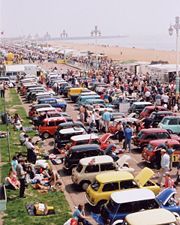
- August 1959: Introduction of the Austin Seven, Morris Mini-Minor and Morris Mini-Minor DL 2-door saloons, all with transversely mounted 848cc engine and 4-speed gearbox.
- 1960: Introduction of the Austin Seven Countryman and Morris Mini-Minor Traveller 3-door estates, both with 848 cc engine from the saloon models.
- 1961: Introduction of the Austin Seven Super and Morris Mini-Minor Super 2-door saloons.
- 1961: Introduction of the Austin Mini Cooper and Morris Mini Cooper 2-door saloon, both with larger 997cc 55 bhp (41 kW) engine.
- January 1962: All former Austin Seven models now officially called Austin Mini.
- 1962: Introduction of the Morris Mini-Minor SDL 2-door saloon.
- March 1963: Introduction of the Austin Mini Cooper 1071 S and Morris Mini Cooper 1071 S 2-door saloons, both with larger 1071cc 70 bhp (52 kW) engine.
- 1964: Introduction of the Mini Moke.
- April 1964: Introduction of the Austin and Morris Mini-Cooper 998, Mini-Cooper 970 S and Mini-Cooper 1275 S. 1275 S models have 1275 cc 76 bhp (57 kW) engine. Automatic transmission available as an option for the 998 cc Austin Mini-Cooper 998 and 1275 S. Previous Mini-Cooper 997 and 1071 S models dropped.
- 1965: Mini Cooper 970 S discontinued.
- October 1965: Automatic transmission now available as an option on standard Austin/Morris Mini and Morris Mini SDL.
- October 1967: Mark 2 range launched with facelift and upgraded equipment. Austin Mini range as follows: 850, 1000, Cooper 998 and Cooper 1275 S 2-door saloons and 1000 Countryman 3-door estate. Morris Mini range as follows: 850, 850 SDL, 1000 SDL, Cooper 998 and Cooper 1275 S 2-door saloons and 1000 Traveller 3-door estate. Optional automatic transmission available on all Austin models (except 850) and Morris Mini 1000 SDL saloon.
- October 1969: Separate Austin and Morris badging now merged into Mini 850/Mini 1000 badging. Range reduced to: 850, 1000, Clubman, Cooper S and 1275 GT 2-door saloons and Clubman 3-door estate. Optional automatic transmission available on all except 1275 GT.
Unproduced prototypes
A number of prototypes produced for vehicles based on the Mini but which never saw production are held and sometimes displayed at the British Heritage Motor Centre museum at Gaydon, Warwickshire. These included the Twini, a re-engineered four-wheel-drive Moke with two engines — one at the front and another at the back; the Austin Ant, a second attempt to produce a four-wheel-drive vehicle, this time using a transfer case; and a two-seater convertible MG edition of the Mini, cancelled due to it being perceived as competition for the MG Midget.
Exotic Minis and celebrities
In the 1960s and 70s, the Mini, in addition to being a cultural icon, also became a veritable ' fashion statement'. Many celebrities of that era drove Minis that had been customised by famous British coachbuilders. Examples include Peter Sellers' wicker side-panelled Mini built by Hooper (the Rolls-Royce coachbuilder) which appeared in his movie A Shot in the Dark. Ringo Starr's hatchback designed by Radford who also built a Mini de Ville for Britt Ekland, Peter Sellers' wife, with a special rear estate wagon door. Radford also built Mini de Villes for John Lennon, Marianne Faithfull and a psychedelic version that appeared in the Beatles movie Magical Mystery Tour owned by George Harrison who maintained it through the years and had it restored, including the art, prior to making an appearance with it at Goodwood as late as June 1998. Marianne Faithfull drove her duo-tone de Ville to the Law Courts to hear Mick Jagger's appeal of his drug conviction in 1967. The same year John Lennon drove his de Ville hatchback to Apple studios after hearing of Brian Epstein's death. At around the same time, Radford also extensively customised a 1275 Mini-Cooper S for Monkee Michael Nesmith which gave dramatically improved performance combined with luxury and silence. In 1969 the Mini became an iconic part of the cult film The Italian Job. The exclusive (and expensive) Margrave and Margrave SE from Wood & Pickett should be mentioned, found at Mayfair dealerships in mod London and elsewhere.
Niki Lauda, Enzo Ferrari and Steve McQueen all owned and drove Mini Coopers.
In September 1977, rock singer Marc Bolan died when the purple Mini 1275GT (reg no. FOX 661L) in which he was a passenger crashed into a tree in Barnes, West London.
Kit cars and customisation
The cheapness, simplicity and easy availability of used Minis make it an ideal candidate for body replacement. There are over 120 Mini-based kit cars from various small companies and individual enthusiasts. There are also numerous dramatically modified Minis such as a set of three street-legal cars made up to look like giant oranges as a promotion for the Outspan company, a Mini that was made to look like a half-timbered cottage, complete with thatched roof and windows with curtains. Some enthusiasts have drastically shortened or lowered their cars to make them yet smaller – others make small versions of stretched limos, double-decker busses, monster trucks, motor homes and many other kinds of vehicles from used Minis.
Years after the Mini finally ended its production run, there are still ample third-party parts – both spares for restoration and performance parts for race tuning.
Given the low weight and good handling of the Mini it is also popular to do an engine swap putting in a modern, high performance engine like the Honda VTEC B16A2 or Suzuki Swift GTi and a rear mounted Yamaha R1 motorbike engine. Or the Vauxhall 16v 2ltr c20 XE "red top" engine
Awards
The Mini has won many awards over the years, perhaps the most notable include: "Car of the Century" ( Autocar magazine 1995), "Number One Classic Car of All Time" ( Classic & Sports Car magazine 1996) and "European Car of the Century" in a worldwide Internet poll run by the prestigious Global Automotive Elections Foundation in 1999. The Mini managed second place (behind the Model T Ford) for "Global Car of the Century" in that same poll.
In the end 5.3 million Minis were sold, making it by far the most popular British car ever made. Thousands of these are still on the road, with the remaining pre-1980s versions being firmly established as collectors' items.
Minis in the United States
Between 1960 and 1967, BMC exported approximately 10,000 left-hand drive BMC Minis to the United States. Sales were discontinued when stricter federal emission standards were imposed; BMC felt that it would be too expensive to make the Mini's engine compliant. Similar legislation was later introduced in Europe, and the A-series engine, with minor modifications, proved perfectly capable of complying with it.
Despite this, a small band of enthusiasts keep the legacy of the original car alive in the U.S., where cars more than 25 years old are generally exempt from emissions regulations. Minis that were originally sold in the U.S. are becoming hard to find, so most of the restored Minis now running in the U.S. have been imported by individual enthusiasts – typically from Australia or New Zealand where the climate has limited the amount of rust formation and cars are available for relatively low prices. There is increasing difficulty in finding cars that are old enough to meet the 25 year emissions exemption and yet are still in a reasonable condition. This has led some importers to place the vehicle identification number (VIN) plates from older cars onto Minis that are less than 25 years old – claiming that the car was "repaired" by replacing every single part with the exception of the VIN plate. Such vehicles are termed "re-VINs" and are surprisingly common .
Popularity
At its peak, the Mini was a strong seller in most of the countries where it was sold, with the United Kingdom inevitably receiving the highest volumes.
It was a huge seller in the mini-car market, which it virtually monopolised until the arrival of the Hillman Imp in 1963. It comprehensively outsold the Imp, and it was 16 years before the Mini received a serious threat to its sales success. This threat came in the shape of the much more modern and practical Vauxhall Chevette of 1975, but the Mini continued to sell in huge volumes and was still very popular when its "replacement" - the Metro - arrived in 1980. By this time, the Mini's design had been overtaken by numerous more modern and practical efforts, but it still offered sheer driving fun that was almost unbeatable in this size of car.
Although the Metro never actually replaced the Mini, production figures for the Mini dipped during the 1980s, and interest in the now-iconic design was not revived until the re-introduction of the famous Mini Cooper in 1989. This helped the car retain its desirability and driver appeal throughout the 1990s, right up to the end of production on 4 October 2000.
Eight years after its demise, the Mini is still a common sight on Britain's roads, and the surviving pre-1980s models in particular are now widely regarded as collector's items.
Safety
Issigonis designed the Mini with an emphasis on active safety. Asked about the crash worthiness of the Mini he said "I make my cars with such good brakes, such good steering, that if people get into a crash it´s their own fault" and "I don’t design my cars to have accidents". It is generally acknowledged that the Mini was designed with excellent handling characteristics.
Nicholas Faith states in his book that Murray Mackay (one of the UK's leading motor vehicle crash and safety researchers) was critical of the pre-1967 Mini's passive safety features, including the protruding filler cap, the door latch, and the vulnerability of the passenger space to engine intrusion.
The Mini was withdrawn from the North American market because it couldn't meet the 1968 U.S. safety regulations, and was never updated to comply with those regulations.
Throughout its life, the Mini was modified in various ways to improve its safety. In 1974 a prototype Mini experimental safety vehicle was built (Mini Clubman SRV4) which featured a longer crumple zone, a "pedestrian friendly" front-end, run-flat tyres, strengthened door sills, extra internal padding and recessed door handles. Jack Daniels, one of the original Issigonis team, is stated to have been working on further safety improvements for the Mini when he retired in 1977. Several times it was thought that safety regulations would stop Mini production Safety improved in 1996, with the introduction of Airbags and side impact bars. The Mini, challenged by increasingly demanding European safety and pollution standards, was planned by British Aerospace to be taken out of production in 1996, but BMW chose to invest to keep the Mini legal until the launch of the BMW MINI.
In January 2007, the Which? magazine listed the Mini City in its "Ten worst cars for safety (since 1983)" list, alongside the Hyundai Pony 1.2L, Fiat Panda 900 Super, Suzuki Alto GL, Daihatsu Domino, Citroën AX 11 RE, Yugo 45 and 55, Peugeot 205 GL, and the Citroën 2CV6.
A UK Department for Transport statistics publication, presenting estimates of the risk of driver injury in two car injury collisions, based on reported road accident data, estimated that the 1990–2000 Mini was one of two small cars (the other being the Hyundai Atoz), which, with an estimated 84% of drivers likely to be injured, presented the greatest risk of driver injury. The average risk for the small car category was 76%.
The new MINI
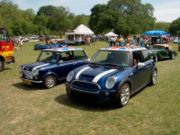
When production of the classic Mini ceased in 2000, BMW (the new owner of the brand) announced the successor to the Mini – which is variously called the "BMW MINI" or the "New MINI". The brand name for the new car is MINI (written in capital letters).
Some Mini enthusiasts reject the claim that the MINI is the natural successor of the original car - others simply dislike it - yet others were amongst the first to buy the new MINI when it was launched. There are many reasons offered for the negative point of view. One notion is that the classic Mini could have continued in viable production for many more years had it not been 'killed off' to make way for the MINI. The new MINI is larger than the classic Mini. It is around 55 centimetres (22 in) longer, 30 centimetres (12 in) wider, weighing 1,050 kg (2,315 lb) rather than 650 kg (1,433 lb). That, together with the departure from the spartan minimalism of the original, has proven objectionable to some enthusiasts. Others resent the manner in which BMW took the Mini brand name from the Rover group. However, many Mini owners take the opposite view and embrace the new car as a logical succession of the original and view it as the only way the concept could have continued in the light of modern safety, emissions and manufacturing principles. Some Mini clubs go so far as to ban MINIs from their club meetings - others actively seek car enthusiasts from both camps. This spectrum of attitudes has been noted with other retro-car releases such as the Volkswagen Beetle and is far from being unique to the Mini community.
On 3rd April 2007, the one millionth MINI rolled out of the Oxford Plant after six years of production - just one month longer than it took the classic Mini to reach the same total in March 1965.
